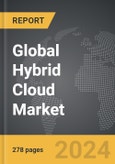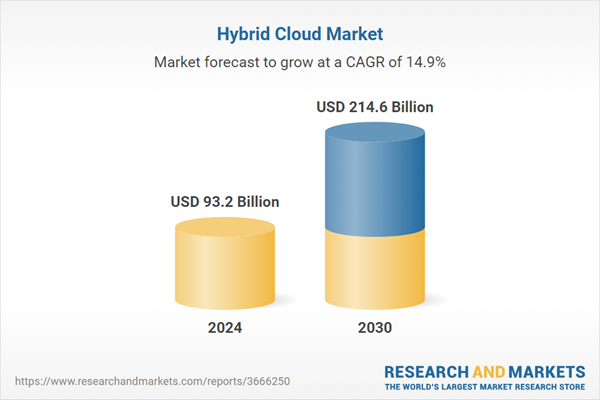The global market for Hybrid Cloud was valued at US$93.2 Billion in 2024 and is projected to reach US$214.6 Billion by 2030, growing at a CAGR of 14.9% from 2024 to 2030. This comprehensive report provides an in-depth analysis of market trends, drivers, and forecasts, helping you make informed business decisions. The report includes the most recent global tariff developments and how they impact the Hybrid Cloud market.
Adopting a hybrid cloud strategy is often driven by the need to manage diverse and dynamic workloads effectively, leveraging public clouds for scalable and cost-effective resources during peak demands and maintaining sensitive workloads securely within private clouds or on-premises environments. This flexibility is ideal for applications like big data analytics, where intensive processing isn't constantly required, allowing organizations to use scalable public resources economically while keeping sensitive data secured. Additionally, organizations transitioning to cloud computing find hybrid models beneficial as they can migrate workloads incrementally, optimizing their infrastructure based on evolving needs and experiences. This strategic flexibility not only accommodates short-term projects and reduces over-investment in physical infrastructure but also supports long-term adjustments to business operations, enhancing overall corporate agility and capacity for innovation.
The growth of the hybrid cloud market is propelled by multiple factors: the increasing need for business agility to quickly adapt to market and technological changes; enhanced risk management capabilities, particularly in data security and regulatory compliance; and the need for technological integration that supports a diverse array of applications and systems, including legacy and cloud-native solutions. Moreover, data sovereignty requirements, scalability, and performance optimization further drive hybrid cloud adoption, allowing organizations to manage workloads efficiently across various environments. Disaster recovery and business continuity are also enhanced in hybrid environments through data redundancy across multiple locations. Additionally, the desire to avoid vendor lock-in and the flexibility to experiment with new innovations without substantial upfront investments are compelling reasons for adopting hybrid cloud solutions. As regulatory landscapes evolve and organizations increasingly prioritize sustainability, hybrid clouds offer adaptable and energy-efficient solutions that support broader business objectives and compliance needs, making them an indispensable component of modern IT infrastructure.
Segments: Component (Solution, Services); Service Model (SaaS, IaaS, PaaS); Organization Size (SMEs, Large Enterprises); Vertical (BFSI, IT & Telecom, Healthcare, Retail, Media & Entertainment, Government, Other Verticals).
Geographic Regions/Countries: World; United States; Canada; Japan; China; Europe (France; Germany; Italy; United Kingdom; Spain; Russia; and Rest of Europe); Asia-Pacific (Australia; India; South Korea; and Rest of Asia-Pacific); Latin America (Argentina; Brazil; Mexico; and Rest of Latin America); Middle East (Iran; Israel; Saudi Arabia; United Arab Emirates; and Rest of Middle East); and Africa.
The analysts continuously track trade developments worldwide, drawing insights from leading global economists and over 200 industry and policy institutions, including think tanks, trade organizations, and national economic advisory bodies. This intelligence is integrated into forecasting models to provide timely, data-driven analysis of emerging risks and opportunities.
Global Hybrid Cloud Market - Key Trends and Drivers Summarized
Hybrid cloud has emerged as a transformative model in modern IT strategies, combining on-premises infrastructure, private cloud services, and public clouds like Amazon Web Services (AWS) and Microsoft Azure. This versatile setup enables businesses to maintain a scalable environment that supports a variety of computing, storage, and service needs, thereby enhancing operational efficiency and agility. By orchestrating these diverse platforms, organizations gain the ability to swiftly adapt to market changes and competitive pressures, balancing IT agendas focused on cost-efficiency with business transformation goals aimed at growth and revenue generation. Public clouds offer scalable and cost-effective solutions with lower upfront capital expenditures, while private clouds provide enhanced data security and control, which is crucial for processing and storing sensitive information. The hybrid cloud model allows organizations to leverage the strengths of both public and private clouds, achieving a balance of cost, performance, and security.Adopting a hybrid cloud strategy is often driven by the need to manage diverse and dynamic workloads effectively, leveraging public clouds for scalable and cost-effective resources during peak demands and maintaining sensitive workloads securely within private clouds or on-premises environments. This flexibility is ideal for applications like big data analytics, where intensive processing isn't constantly required, allowing organizations to use scalable public resources economically while keeping sensitive data secured. Additionally, organizations transitioning to cloud computing find hybrid models beneficial as they can migrate workloads incrementally, optimizing their infrastructure based on evolving needs and experiences. This strategic flexibility not only accommodates short-term projects and reduces over-investment in physical infrastructure but also supports long-term adjustments to business operations, enhancing overall corporate agility and capacity for innovation.
The growth of the hybrid cloud market is propelled by multiple factors: the increasing need for business agility to quickly adapt to market and technological changes; enhanced risk management capabilities, particularly in data security and regulatory compliance; and the need for technological integration that supports a diverse array of applications and systems, including legacy and cloud-native solutions. Moreover, data sovereignty requirements, scalability, and performance optimization further drive hybrid cloud adoption, allowing organizations to manage workloads efficiently across various environments. Disaster recovery and business continuity are also enhanced in hybrid environments through data redundancy across multiple locations. Additionally, the desire to avoid vendor lock-in and the flexibility to experiment with new innovations without substantial upfront investments are compelling reasons for adopting hybrid cloud solutions. As regulatory landscapes evolve and organizations increasingly prioritize sustainability, hybrid clouds offer adaptable and energy-efficient solutions that support broader business objectives and compliance needs, making them an indispensable component of modern IT infrastructure.
Report Scope
The report analyzes the Hybrid Cloud market, presented in terms of units. The analysis covers the key segments and geographic regions outlined below.Segments: Component (Solution, Services); Service Model (SaaS, IaaS, PaaS); Organization Size (SMEs, Large Enterprises); Vertical (BFSI, IT & Telecom, Healthcare, Retail, Media & Entertainment, Government, Other Verticals).
Geographic Regions/Countries: World; United States; Canada; Japan; China; Europe (France; Germany; Italy; United Kingdom; Spain; Russia; and Rest of Europe); Asia-Pacific (Australia; India; South Korea; and Rest of Asia-Pacific); Latin America (Argentina; Brazil; Mexico; and Rest of Latin America); Middle East (Iran; Israel; Saudi Arabia; United Arab Emirates; and Rest of Middle East); and Africa.
Key Insights:
- Market Growth: Understand the significant growth trajectory of the Solution segment, which is expected to reach US$138.9 Billion by 2030 with a CAGR of a 14.1%. The Services segment is also set to grow at 16.4% CAGR over the analysis period.
- Regional Analysis: Gain insights into the U.S. market, valued at $24.8 Billion in 2024, and China, forecasted to grow at an impressive 20.0% CAGR to reach $50.9 Billion by 2030. Discover growth trends in other key regions, including Japan, Canada, Germany, and the Asia-Pacific.
Why You Should Buy This Report:
- Detailed Market Analysis: Access a thorough analysis of the Global Hybrid Cloud Market, covering all major geographic regions and market segments.
- Competitive Insights: Get an overview of the competitive landscape, including the market presence of major players across different geographies.
- Future Trends and Drivers: Understand the key trends and drivers shaping the future of the Global Hybrid Cloud Market.
- Actionable Insights: Benefit from actionable insights that can help you identify new revenue opportunities and make strategic business decisions.
Key Questions Answered:
- How is the Global Hybrid Cloud Market expected to evolve by 2030?
- What are the main drivers and restraints affecting the market?
- Which market segments will grow the most over the forecast period?
- How will market shares for different regions and segments change by 2030?
- Who are the leading players in the market, and what are their prospects?
Report Features:
- Comprehensive Market Data: Independent analysis of annual sales and market forecasts in US$ Million from 2024 to 2030.
- In-Depth Regional Analysis: Detailed insights into key markets, including the U.S., China, Japan, Canada, Europe, Asia-Pacific, Latin America, Middle East, and Africa.
- Company Profiles: Coverage of players such as Abiquo Europe Ltd, Amazon Web Services, Inc., Atlantic.Net, Cisco Systems Inc., Dell EMC and more.
- Complimentary Updates: Receive free report updates for one year to keep you informed of the latest market developments.
Some of the 211 companies featured in this Hybrid Cloud market report include:
- Abiquo Europe Ltd
- Amazon Web Services, Inc.
- Atlantic.Net
- Cisco Systems Inc.
- Dell EMC
- Dell Technologies Inc.
- Equinix, Inc.
- Expedient
- Fujitsu Limited
- Google LLC
- Hewlett Packard Enterprise Company
- IBM Corp.
- Microsoft Corp.
- Oracle Corporation
- Panzura
- RightScale Inc.
- VMware Inc.
Tariff Impact Analysis: Key Insights for 2025
Global tariff negotiations across 180+ countries are reshaping supply chains, costs, and competitiveness. This report reflects the latest developments as of April 2025 and incorporates forward-looking insights into the market outlook.The analysts continuously track trade developments worldwide, drawing insights from leading global economists and over 200 industry and policy institutions, including think tanks, trade organizations, and national economic advisory bodies. This intelligence is integrated into forecasting models to provide timely, data-driven analysis of emerging risks and opportunities.
What’s Included in This Edition:
- Tariff-adjusted market forecasts by region and segment
- Analysis of cost and supply chain implications by sourcing and trade exposure
- Strategic insights into geographic shifts
Buyers receive a free July 2025 update with:
- Finalized tariff impacts and new trade agreement effects
- Updated projections reflecting global sourcing and cost shifts
- Expanded country-specific coverage across the industry
Table of Contents
I. METHODOLOGYII. EXECUTIVE SUMMARY2. FOCUS ON SELECT PLAYERSIII. MARKET ANALYSISCANADAITALYSPAINRUSSIAREST OF EUROPESOUTH KOREAREST OF ASIA-PACIFICARGENTINABRAZILMEXICOREST OF LATIN AMERICAIRANISRAELSAUDI ARABIAUNITED ARAB EMIRATESREST OF MIDDLE EASTIV. COMPETITION
1. MARKET OVERVIEW
3. MARKET TRENDS & DRIVERS
4. GLOBAL MARKET PERSPECTIVE
UNITED STATES
JAPAN
CHINA
EUROPE
FRANCE
GERMANY
UNITED KINGDOM
ASIA-PACIFIC
AUSTRALIA
INDIA
LATIN AMERICA
MIDDLE EAST
AFRICA
Companies Mentioned (Partial List)
A selection of companies mentioned in this report includes, but is not limited to:
- Abiquo Europe Ltd
- Amazon Web Services, Inc.
- Atlantic.Net
- Cisco Systems Inc.
- Dell EMC
- Dell Technologies Inc.
- Equinix, Inc.
- Expedient
- Fujitsu Limited
- Google LLC
- Hewlett Packard Enterprise Company
- IBM Corp.
- Microsoft Corp.
- Oracle Corporation
- Panzura
- RightScale Inc.
- VMware Inc.
Table Information
| Report Attribute | Details |
|---|---|
| No. of Pages | 278 |
| Published | April 2025 |
| Forecast Period | 2024 - 2030 |
| Estimated Market Value ( USD | $ 93.2 Billion |
| Forecasted Market Value ( USD | $ 214.6 Billion |
| Compound Annual Growth Rate | 14.9% |
| Regions Covered | Global |









